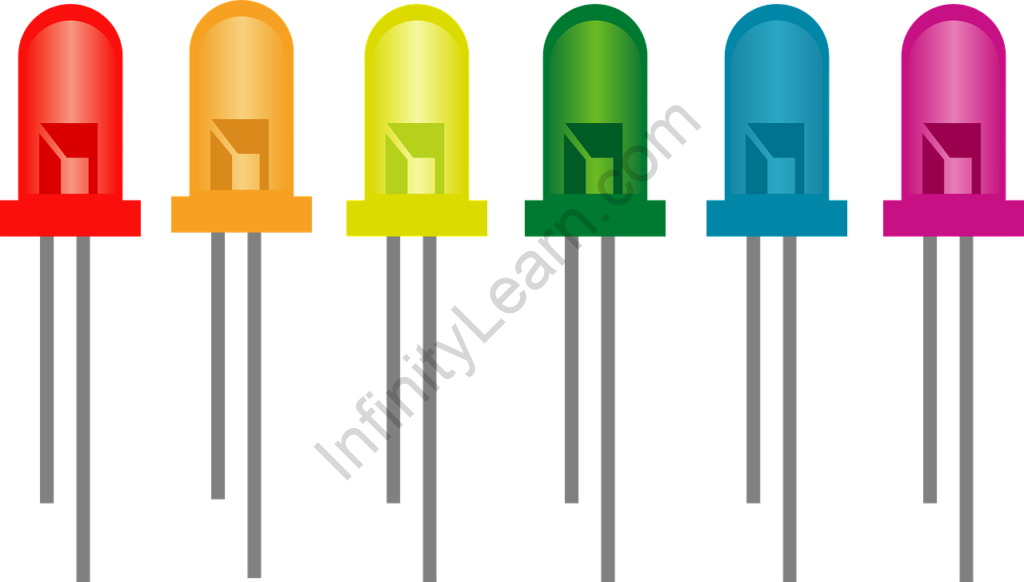Table of Contents
LEDs can be found in our phones, cars, and even our homes. When something electronic lights up, there’s a good chance that an LED is at the heart of it. These are available in a wide variety of sizes, shapes, and colours, but they all have one thing in common: they’re the bacon of electronics. They’re widely claimed to improve any project, and they’re frequently added to unexpected things (much to everyone’s delight). A LED is made up of a PN Junction Diode, and when a voltage is applied to it, electrons and holes recombine in the PN Junction, releasing energy in the form of light (Photons). An LED’s electrical symbol is similar to that of a PN Junction Diode. To make an LED, the n-type material should be negatively charged and the p-type material should be positively charged. LEDs utilise semiconductors that, when forward biassed, emit either visible light or invisible infrared light. When free electrons in the conduction band recombine with holes in the valence band in forwarding bias, energy is released in the form of light. Light Emitting Diodes could be manufactured to emit all visible wavelengths, ranging from red (620nm to 750nm) to blue – violet (380nm to 490nm). The light emitted by such an LED is typically monochromatic, which means it has a single colour that is determined by the semiconductor’s energy band gap.

Overview
Led light bulbs have quite a shorter useful life than other types of lighting, such as incandescent or compact fluorescent lighting (CFL). LEDs really aren’t known to “burn out” or fail. Rather, they suffer from ‘lumen depreciation,’ which causes the LED’s brightness to gradually fade over time. Unlike incandescent bulbs, LED “lifetime” is based on predicting when the light output drops by 30%.
Each and every LED can be used as a light source in a short-range fibre-optic transmission system, that is, one that is less than 100 metres long (330 feet). Even so, for long-distance fibre optics, the emission properties of the light source are chosen to match the transmission properties of the optical fibre, and in this case, infrared LEDs are a better match than visible-light LEDs. Glass optical fibres have the lowest transmission losses in the infrared region, between 1.3 and 1.55 micrometres. LEDs made of gallium indium arsenide phosphide layered on an indium phosphide substrate are used to match these transmission properties. The material’s exact composition can be adjusted to emit energy precisely at 1.3 or 1.55 micrometres.
LEDs: Construction and Working
In electronics, an LED (light-emitting diode) is a semiconductor device that emits infrared or visible light when charged with an electric current. Visible LEDs are used as indicator lamps in many electronic devices, as rear-window and brake lights in automobiles, and as alphanumeric displays or even full-colour posters on billboards and signs. Infrared LEDs are used as light sources in fibre-optic telecommunication systems, as well as autofocus cameras and television remote controls.
The acquainted lightbulb emits light via incandescence, a phenomenon in which an electric current heats a wire filament, causing the wire to emit photons, the basic energy packets of light. LEDs work through electroluminescence, a phenomenon in which photons are emitted as a result of electronic excitation of a material. Gallium arsenide is the most common material used in LEDs, but there are many variations on this basic compound, such as aluminium gallium arsenide or aluminium gallium indium phosphide. Such compounds belong to the so-called III-V group of semiconductors, which are compounds composed of elements from columns III and V of the periodic table.
The wavelength (and thus the colour) of the emitted light can be changed by varying the precise composition of the semiconductor. LED emission is typically in the visible region of the spectrum (i.e., wavelengths ranging from 0.4 to 0.7 micrometres) or in the near-infrared region (with wavelengths between 0.7 and 2.0 micrometres). The brightness of light emitted by an LED is determined by the power emitted by the LED as well as the relative sensitivity of the eye at the emitted wavelength. The maximum sensitivity is at 0.555 micrometres, which is in the yellow-orange and green region. The applied voltage in most LEDs is quite low, around 2.0 volts; the current varies depending on the application and ranges from a few milliamperes to several hundred milliamperes.

The phrase diode refers to the light-emitting device’s twin-terminal structure. A wire filament, for example, is connected to a battery via two terminals, one (the anode) carrying the negative electric charge and the other (the cathode) carrying the positive charge in a flashlight. The “terminals” in LEDs, like those in other semiconductor devices such as transistors, are actually two semiconductor materials with different compositions and electronic properties that are brought together to form a junction. The charge carriers in one material (the negative, or n-type, semiconductor) are electrons, while the charge carriers in the other (the positive, or p-type, semiconductor) are “holes” created by the absence of electrons. Current can be made to flow across the p-n junction under the influence of an electric field (supplied by a battery, for example, when the LED is turned on), supplying the electronic excitation that causes the material to glow.
In some kind of a typical LED structure, the clear epoxy dome functions as a structural element to hold the lead frame together, a lens to focus the light, and a refractive index match to allow more light to escape from the LED chip. This same chip, which is typically 250 250 250 micrometres in size, is installed in a reflecting cup formed in the lead frame. The p-n-type GaP:N layers represent nitrogen added to gallium phosphide, resulting in green emission; the p-n-type GaAsP:N layers represent nitrogen added to gallium arsenide phosphide, resulting in orange and yellow emission; and the p-type GaP:Zn,O layer represents zinc and oxygen added to gallium phosphide, resulting in red emission. LEDs based on aluminium gallium indium phosphide, which emit light efficiently from green to red-orange, and blue-emitting LEDs based on silicon carbide or gallium nitride were both developed in the 1990s. Blue LEDs could be combined with other LEDs in a cluster to produce all colours, including white, for full-colour moving displays.
Characteristics Curve of LED
The LED characteristics curve demonstrates that a forward bias of 1 V is enough to increase the current exponentially. The output characteristics curve demonstrates that the radiant power of an LED is directly proportional to its forward current.
LEDs and Heat
Heat sinks are used in LEDs to absorb the heat produced by the LED and dissipate it into the surrounding environment. As a consequence, LEDs are kept from overheating and burning out. Thermal management is generally regarded as the single most important factor in an LED’s long-term performance. The faster the light degrades and the shorter the useful life of LEDs, the higher the temperature at which they are used.
To manage heat, LED products employ a variety of unique heat sink designs and configurations. Today, material advancements have enabled manufacturers to create LED bulbs that mimic the shapes and sizes of traditional incandescent bulbs. Irrespective of heat sink design, all LED products that have earned the ENERGY STAR have been tested to ensure that they properly manage heat and maintain light output until the end of their rated life.
Types of LEDs
Through-Hole LEDs: One such type of LED is available in a variety of sizes and shapes, the most common of which are 3 mm, 5 mm, and 8 mm. They come in a variety of colours, including red, blue, yellow, white, and green.
SMD LEDs: Surface mount or SMD LEDs (9 Surface Mount Light-Emitting Diodes) in a special package can be easily mounted on the surface of the PCB. They are usually differentiated based on their physical dimensions. The far more popular SMD LEDs, for example, are 3528 and 5050.
Bi – color LEDs: Bi-color LEDs are LEDs that can emit two colours. They are comprised of three leads, two anodes, and a common cathode. The colour is activated based on the configuration of the leads.
RGB LED: RGB LEDs (Red-Blue-Green LED) are the most popular among designers and hobbyists. Among certain computer technicians, the use of RGB LEDs in motherboards, RAM, computer cases, and other components is popular. RGB LEDs have three LEDs on a single chip, and the output of RGB LEDs can be controlled to produce a wide range of colours using a technique known as PWM (Pulse Width Modulation).
High Power LEDs: When the power rating of an LED is greater than or equal to 1 Watt, it is referred to as a High Power LED, as normal LEDs have a power dissipation of a few milliwatts. High-power LEDs are extremely bright and are frequently used in flashlights, spotlights, automobile headlamps, and other applications.
Advantages of LEDs over Incandescent Power Lamps
The following are some advantages of LEDs over incandescent power lamps:
- LEDs use less power and have a lower operating voltage.
- LEDs require no warm-up time.
- The light emitted would be monochromatic.
- They have a long life and are tough.
Uses of LEDs
LEDs are used in a variety of fields, including optical communication, alarm and security systems, remote-controlled operations, robotics, and so on. It is used in a variety of applications due to its long-lasting capability, low power requirements, quick response time, and fast switching capabilities. Listed below are a few of the standards that LED employs:
- Backlighting for televisions
- Being used in displays
- Being used in automobiles
- LEDs are being used to dim lights.
FAQs
What is the principle of operation of a light-emitting diode?
A two-lead semiconductor light source is referred to as a light-emitting diode (LED). Whenever triggered, it is a p–n junction diode that emits light. If a proper voltage is applied to the leads, electrons can recombine with electron holes within the device, releasing energy in the form of photons.
What is the power consumption of LED?
The electricity consumption of a light bulb is measured in kWh. An LED bulb consumes 127.5KWh over its 15,000-hour lifespan. Incandescent bulbs that have been replaced with LED bulbs for 15,000 hours (theoretically; incandescent bulbs do not last that long) use 900KWh of electricity.
What is the duration of LED’s working?
Numerous LEDs are rated to last up to 50,000 hours. This really is nearly 50 times the life of an incandescent bulb, 20-25 times the life of a halogen bulb, and 8-10 times the life of a CFL bulb. If you use LED 12 hours a day, a 50,000 bulb will last more than 11 years.





